S.Q. Eries's Blog, page 62
December 24, 2012
GA: Geijutsuka Art Design Class Vol. #04 Manga Review
 While most manga are written in chapter format that does not mean the comic strip is unknown to Japanese artists. Known as 4-Koma manga, four-panel comic strips aren’t nearly as widespread as their long-format counterparts, but they are no less entertaining.
While most manga are written in chapter format that does not mean the comic strip is unknown to Japanese artists. Known as 4-Koma manga, four-panel comic strips aren’t nearly as widespread as their long-format counterparts, but they are no less entertaining.
One of the few 4-Koma titles translated to English is GA: Geijutsuka Art Design, a lighthearted series centered around five art students. Yen Press has recently released Volume 4 and you can read on for the review.
Back Cover Blurb
It’s time once again for art school, full of the spirit, love, and laughter of youth! Kisaragi and the GA girls return to class, shifting their focus to the history of Western fashion and textiles. But as with every serious art lesson in this department, crazy antics (not to mention a game of dress-up and a food fight) are never far off! And when the GA welcomes a new face – a transfer student from France – will the department’s regulars scare off the new girl and make her hightail it back to her homeland?!
The RevieW
The cover touts this volume as “GA History of Fashion,” and indeed there are five installments of “Fashion Lore,” color pages that provide a mini-history of Western clothes. It’s fun to see the characters in different outfits as they explain the designs of various eras, and the Professor looks absolutely exquisite in ancient Greek dress. They also cross-reference the Western styles with their contemporaries from Japan and other lands, and unless you’re well read on worldwide clothing terminology, you’ll find yourself flipping to the notes to figure out what they are.
For those who enjoy a bit of dress-up, you’ll also get to see the GA girls in Halloweenish costumes when Sasamoto-sensei has his class undergo a modeling/sketching exercise. The front cover is actually a color illustration of the GA girls in the outfits from that segment. Kiyuduki-sensei also takes the opportunity to show several other classmates in costume, and this arc includes two color pages.
If you’re still hungry for fashion, there’s yet another fashion-themed arc towards the end of the book. Instead of the Japanese GA girls exploring Western fashion, it’s a Western (French) exchange student, Marianne Van Tienen, learning about the Japanese yukata in textile class. The girls turn it into an interesting discussion on fashion, trends, and Western-Japanese fusion. However, you will need the translation notes as the girls use several Japanese terms in their jokes, one of which is a kanji pun.
As for the remainder of the book, it’s a mixed bag of general school silliness with various brief arcs focused on the Art Design Club, the GA third years, and even the teachers. There are four pages of translation notes, and yes, you will need them. For the most part, the explanations allow you to get the point of the narrative, but there were a few van Gogh jokes in the Uozumi-kun colorblind arc that I didn’t quite understand even with the notes. On the other hand, Noda’s adventures with the lost and found box, which was one of the more creative arcs, was laugh out loud funny thanks to Kiyuduki-sensei’s visuals of art tools wreaking havoc on the comic strip.
In Summary
The GA girls maintain their usual brand of silly classroom humor, this time with a fashion twist. For those who like learning about the history of clothes or seeing characters in different outfits, this is the copy to pick up. But be warned. Though the visuals are consistently cute, full understanding of the comic strips requires flipping to the translation notes as the topics range everywhere from Japanese ukiyo-e art to tetrachromacy to silver electroplating.
First published at the Fandom Post.


December 17, 2012
Manga Review: Oresama Teacher Vol. #10
 Mafuyu is a high school delinquent who wants to turn over a new leaf. So when she transfers schools, she thinks she’ll finally be able to live the life of a normal girl. There’s just one problem: her teacher Mr. Saeki is a bigger delinquent than she is and is out to take advantage of her fighting skills!
Mafuyu is a high school delinquent who wants to turn over a new leaf. So when she transfers schools, she thinks she’ll finally be able to live the life of a normal girl. There’s just one problem: her teacher Mr. Saeki is a bigger delinquent than she is and is out to take advantage of her fighting skills!
Oresama Teacher is a shojo manga that offers humor of the silly variety. Volume 10 has recently been released, and you can read on for the review. (For those who are interested, you can click here for my reviews of earlier volumes).
Back Cover Blurb
Yui might be a spy for the Student Council, but he still takes his duties as a member of the Public Morals Club very seriously! When he notices that the club has been a little stagnant lately, he decides to liven things up with some ninja training. But while he’s whipping Mafuyu and Hayasaka into shape, forces on the Student Council are working against him…
The RevieW
Yui’s been fraternizing with the Public Morals Club for a while now. He remains loyal to Miyabi, yet he gets along with Hayasaka and Mafuyu and helped them foil Kosaka’s plot in the previous volume. All of which begs the question, whose side is he really on now? Just as Mafuyu ponders that matter, Tsubaki-sensei introduces a new character who’s taken Yui’s “betrayal” to the Public Morals Club rather personally.
Enter Wakana Hojo. She and Yui share some history that Tsubaki-sensei describes in detail in Chapter 57. Wakana’s like Yui in that she’s fiercely loyal to Miyabi (though for entirely different reasons), and she’s the physical type (her weapon of choice is a bamboo sword). But while Yui’s simpleminded to the point of being an idiot, Wakana’s more complicated and so are her feelings for Yui.
The two face off when Wakana conducts the Student Council’s annual club audit. Unfortunately, the Public Morals Club has been lax in its record-keeping, and for such clubs, the only way to avoid being shut down is to take the Student Council’s stamp of approval by force. For Yui and Wakana, the fight for the stamp has an added layer of emotional complexity because Yui was originally supposed to be auditor. Despite her determined mindset, Wakana’s tough front slips whenever they clash, and though it’s obvious to others that her feelings for Yui are the cause, Yui’s too dense to recognize it.
In the midst of Yui trying to decipher the mysteries of female emotions, there are plenty of comedy and chase scenes with all manner of random clubs popping up to get approval. Super Bun makes an appearance, and Hayasaka, though he’s not the star of this volume, proves surprisingly resourceful in this arc. Tsubaki-sensei also throws in a moment of sexual tension between Takaomi and Mafuyu, but it comes completely out of nowhere and feels forced.
In Summary
Not surprisingly, Volume 10 kicks off with a new challenge for the Public Morals Club and a new Student Council enemy to go with it. What is somewhat unexpected is that Yui plays such a large role in these chapters. In addition to his usual spy wackiness, council member Wakana brings out a side of him that’s probably as close to sensitive as the Miyabi-obsessed, wannabe spy is going to get.
First published at the Fandom Post.


December 13, 2012
A Tour of Japanese Pop Culture, Part 12: Komazawa School Festival!
Our vacation culminated with a visit to the Komazawa Girls’ School Festival, a destination truly off the beaten track. For those unfamiliar with Japanese high school culture, these festivals or bunkasai are as commonplace as homecoming or prom in the United States. Watch any Japanese drama or anime with a high school setting, and you can pretty much count on a bunkasai episode. Having seen so many anime/drama depictions, we wanted to experience the real deal. Not all are open to the public, but thanks to an Okinawan friend, we found one scheduled at the time of our trip.
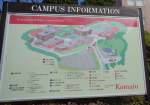 We knew nothing about Komazawa other than it was an all-girls school prior to our visit, and we were floored by what we found. Located in the affluent suburb of Inagi City, Komazawa is actually a middle school, high school, and university and definitely on the prestigious end. The campus is huge, boasting a gorgeous track and koi pond, and the girls bathroom was bright and shiny as a Yogurtland parlor.
We knew nothing about Komazawa other than it was an all-girls school prior to our visit, and we were floored by what we found. Located in the affluent suburb of Inagi City, Komazawa is actually a middle school, high school, and university and definitely on the prestigious end. The campus is huge, boasting a gorgeous track and koi pond, and the girls bathroom was bright and shiny as a Yogurtland parlor.
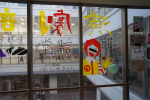
Festival Decorations. And no, I have no idea what the McDonald’s pic is about.
But even though Komazawa is a high-class place, its bunkasai contained many of the elements we’d anticipated: various booths, handmade posters, high school boys coming to check out the girls. The main stage was in a courtyard surrounded by food stalls selling curry, noodles, hot dogs, tapioca drinks, takoyaki, and cotton candy. There were no plays the day we attended, but they had several music and dance performances.
Based on the three rock bands we saw, there’s some correlation between Japanese rocker wardrobe and cosplay. One band dressed like nurses, and another had a drummer that looked just like anime idol Hatsune Miku. We didn’t know any of the songs, but watching them play their hearts out to the cheers of their fans (a few in cosplay also!) was pretty cool.
As for the dancers, their performances looked like music video dance routines. The music was all canned, but most girls lip-synched as they did their best idol group imitations. Again, we didn’t recognize any the songs or groups, but they drew a huge crowd and we had fun watching them.
 Other festival entertainment included various game booths, most of which required 100 or 50 yen to play. In the gymnasium, however, the sports clubs had free games. From the looks of it, they were simply trying to promote their clubs. The kendo club had a whack-balloon-with-shinai (bamboo sword) game; the soccer club had a kicking game; the softball team had a throwing game; and the archery club had a shoot-the-balloon game (with a real bow!). We don’t really see kendo or Japanese archery at home so it was cool to see students in hakama showing people the proper way to hold a bow or shinai.
Other festival entertainment included various game booths, most of which required 100 or 50 yen to play. In the gymnasium, however, the sports clubs had free games. From the looks of it, they were simply trying to promote their clubs. The kendo club had a whack-balloon-with-shinai (bamboo sword) game; the soccer club had a kicking game; the softball team had a throwing game; and the archery club had a shoot-the-balloon game (with a real bow!). We don’t really see kendo or Japanese archery at home so it was cool to see students in hakama showing people the proper way to hold a bow or shinai.
Over by the main school building, the students had rearranged and decorated their classrooms just like we’d seen on TV. In manga, you can pretty much count on a bunkasai with a haunted house or a butler/maid café. As it turned out, Komazawa had no maids; the closest we got was green tea and manju served by the kimono-garbed tea ceremony club in its tatami-floored classroom (though that was quite fun).
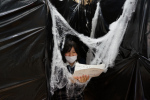 However, we did see one classroom swathed in black plastic sheeting. Thinking it was a haunted house, we went in. Inside was a maze made of cardboard and black plastic. But when we turned the first corner, instead of a student in a scary costume, we were greeted by a girl holding up a sheet with a question on it. As it turned out, it was a Halloween (?) themed quiz game! We encountered four more girls with questions in the maze, and fortunately it was multiple choice. In the end, I won a prize for getting three questions right while my husband got a smaller prize for one correct answer.
However, we did see one classroom swathed in black plastic sheeting. Thinking it was a haunted house, we went in. Inside was a maze made of cardboard and black plastic. But when we turned the first corner, instead of a student in a scary costume, we were greeted by a girl holding up a sheet with a question on it. As it turned out, it was a Halloween (?) themed quiz game! We encountered four more girls with questions in the maze, and fortunately it was multiple choice. In the end, I won a prize for getting three questions right while my husband got a smaller prize for one correct answer.
Apparently, challenges were all the rage for this school. Another class had a four-part challenge consisting of a timed chopsticks skills test, a throwing game, name that tune, and a model strut (yup, they had a little catwalk set up in the classroom). We had a lot of fun with that, thanks mainly to one girl who had a decent grasp of English. She was able to explain all the rules to us, though it took a bit of charades to get the idea of the model strut across.
Although that girl and her class were the most memorable for us, we enjoyed interacting with all the students. Some got quite shy when they realized we were from America while others got super excited and wanted to pose for pictures with us. You could tell they hadn’t expected random foreigners.
 Neither did the faculty and parents. Several adults were lending a hand at booths or taking their families around. In particular, there were a bunch with children all wearing the same elementary school uniform. Prospective students, maybe? Anyway, occasionally my husband and I would be trying to decipher what a particular booth or display was about, and a parent or teacher would offer us an explanation in fluent English. As it turns out, many within this community go to university in the United States. And after helping us out, they inevitably asked, “So why did you decide to travel here?”
Neither did the faculty and parents. Several adults were lending a hand at booths or taking their families around. In particular, there were a bunch with children all wearing the same elementary school uniform. Prospective students, maybe? Anyway, occasionally my husband and I would be trying to decipher what a particular booth or display was about, and a parent or teacher would offer us an explanation in fluent English. As it turns out, many within this community go to university in the United States. And after helping us out, they inevitably asked, “So why did you decide to travel here?”
Inagi City is over an hour by train from Tokyo, and school festivals are local events. My husband and I were pretty much the equivalent of foreign tourists to San Francisco taking a detour to Walnut Creek for a high school homecoming game. I don’t know if they thought we were nuts to make so much effort to visit Inagi for the reasons we did, but they all did their best to make our trip worthwhile.
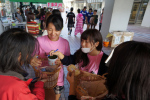
Last minute purchase for the Americans!
The girls, I think, were amused by our presence. We stayed until closing, and by that time, a good portion of them knew they had Americans in their midst and waved as we went by. One group trying to sell the last of their festival merchandise rushed up to us in hopes that we’d make a purchase.
We bought two bags of their sugar butter toast snacks. They were trying so hard to make their sales pitch in English we just had to reward them.
Like I said, this experience was definitely off the beaten track, but it turned out to be the highlight of our trip, and we’re glad we could experience a bit of Japanese culture most foreigners don’t get to see.


December 10, 2012
A Tour of Japanese Pop Culture, Part 11: The Atami Guide Club
So the Atami Guide Club was a part of our trip that we kind of stumbled upon. Being onsen (thermal hot spring) fans, we wanted to visit a seaside hot spring after our guided tour concluded, and our group tour guide recommended a ryokan onsen in Ajiro, a small fishing village in the Atami area, two hours by train from Tokyo. Since my husband and I would be sans guide and helpful friends for this part of our vacation, we did a little pre-trip research on local attractions, and the Atami Guide Club popped up on a Google search.
We weren’t quite sure what to make of the club at first. Their website at the time wasn’t the sleekest and didn’t indicate affiliations with any tourist organizations. Still, their English-language blog had a relatively recent post, and we had nothing to lose by contacting them. A short e-mail interchange ensued, and we wound up booking a half-day tour of Atami with an English-speaking guide and his assistant for ¥1000.
Yep, ¥1000. Less than $15 for a private tour!
I must confess, the super low price (and lack of affiliates on their website) had me a little concerned. Part of me wondered if it was a yakuza scam to kidnap foolish tourists and sell off their organs. But Japan is a relatively safe country, and we’d chosen the Atami train station, a crowded public area, as our meeting spot, so off we went.
As it turned out, we had nothing to worry about. Our meeting time was 9:30 AM, but we arrived at Atami Station at 9:15 AM to find two seniors in “Atami Guide Club” windbreakers already at the turnstile, holding a sign with our names. That was how we met our guides, Henry-san and Kazu-san.
Both are retired professionals. Henry-san lived several years in Britain and has a daughter that lives in the States. Kazu-san worked for the Japanese Embassy and was once stationed in Europe. They spoke English quite well and were wonderful hosts.
That particular morning a typhoon was moving into the area. So after providing us with Atami brochures and information (if the local Atami Tourist Division doesn’t have a link promoting the Atami Guide Club, they really ought to) and showing off the Atami Station hot spring and geyser, Henry-san proposed using his car for the rest of the tour so we wouldn’t get stuck if it rained.
After days of touring Tokyo by train and foot, we were floored by the offer.
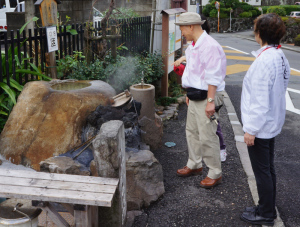
Henry-san and Kazu-san demonstrating how to cook eggs at Kosawa Hot Spring.
So the four of us hopped into Henry-san’s little Toyota sedan, which took us up and down Atami to see the sights. They included the 2000-year-old camphor tree at Kinomiya Shrine; the Kosawa Hot Spring, which has a little steamer basket that you can use to cook eggs; and the Oh-Yu Geyser, the third largest geyser in the world (though all of us agreed Oh-Yu was nothing compared to Old Faithful).
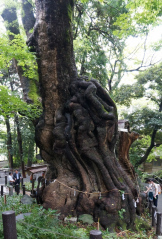
2000-Year-Old Camphor
As we toured about, Henry-san, who was the lead guide, gave explanations of the cultural and historical significance of the sites we visited. As he delivered his mini lectures, he rather reminded me of my dad in that he was a bit pedantic in his explanations. Kazu-san, on the other hand, was more laid back as we chatted about everything from seasonal flowers to grocery stores. It was actually a pretty good combination for a tour team.
By the time we finished admiring the 2000-year-old camphor tree, the wind was starting to pick up. Our guides had intended to take to the seashore, but with rain imminent, they suggested we go instead to Kiunkaku, a villa built by a shipping magnate in 1919. That turned out to be a good move because it started raining once we arrived.
 It was also nice because I enjoy old and interesting architecture, and Kiunkaku boasts a gorgeous garden and buildings constructed in classical Japanese as well as blended Oriental-Western styles. A couple rooms reminded me of Hearst Castle, actually.
It was also nice because I enjoy old and interesting architecture, and Kiunkaku boasts a gorgeous garden and buildings constructed in classical Japanese as well as blended Oriental-Western styles. A couple rooms reminded me of Hearst Castle, actually.
The grounds also include a music hall and a multipurpose room, which are available for rent. The day we visited, a society of retired principals was holding a convention in the musical hall, but Kazu-san told us she frequently attend concerts at Kiunkaku and most recently went to a Latin music recital there.
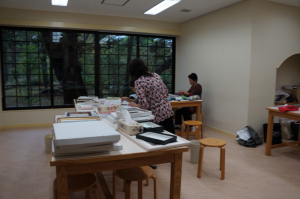
Pressed Flower Craftswomen
As for the multipurpose room, we found a handful of women at work on pressed floral crafts inside. Thanks to Kazu-san, they let us come over to watch them, see their raw materials, and look at their finished crafts. It’s painstaking work from the looks of it, and the results can be quite extraordinary.
We left Kiunkaku at 1 PM, and our tour concluded with them dropping us off at Jonathan’s Family Restaurant so my husband and I could have lunch there. I think they were probably amused that we chose to eat at a chain restaurant when we were in a town known for its seafood, but they simply smiled and told us that they often held their guide club meetings at Jonathan’s.
 All in all, our guides were a fun pair. I never did ask them the particulars of their club, but I get the feeling that they’re all volunteers with a desire to turn Atami into a popular tourist destination. They certainly take their job seriously. In addition to English, Atami guide club also offers tours in Korean and Chinese. (Henry-san told us that he once helped guide a group of a dozen Chinese tourists and tried to get a dozen eggs into the Kosawa steamer basket, which typically cooks four at a time.) And though there are 40 members in the club, only a quarter of them make the grade for lead guide. So if you wind up in the economy area, look them up. They’ll take great care of you.
All in all, our guides were a fun pair. I never did ask them the particulars of their club, but I get the feeling that they’re all volunteers with a desire to turn Atami into a popular tourist destination. They certainly take their job seriously. In addition to English, Atami guide club also offers tours in Korean and Chinese. (Henry-san told us that he once helped guide a group of a dozen Chinese tourists and tried to get a dozen eggs into the Kosawa steamer basket, which typically cooks four at a time.) And though there are 40 members in the club, only a quarter of them make the grade for lead guide. So if you wind up in the economy area, look them up. They’ll take great care of you.


December 6, 2012
A Tour of Japanese Pop Culture, Part 10: Toilets and Restrooms
When traveling, there are certain places you can avoid going, but the restroom is not one of them. In Japan, facilities range from basic to ridiculously high-tech. The thing most Western travelers have to be prepared for is the squat toilet. No seat, just a ceramic trough set in the floor that you straddle-squat over to do your business. Some versions have a horizontal bar on the wall for you to hang onto.
These are the toilets you’ll likely encounter in older areas. Many Japanese consider this more hygienic than Western toilets because you don’t come into contact with any surfaces. I don’t find the squatting aspect difficult per se, but I am always fearful of my clothes falling into that trough. (Not sure how ladies with really long skirts manage it.)
 If you’re visiting a new or remodeled area, both squat and Western toilets will generally be available. Some Western-style toilets I encountered were exactly like those in the United States. Others had slight modifications, like this one with a tank top sink as a space- and water-saving feature. But the vast majority were on a completely different level, featuring a variety of seat settings and bidet functions.
If you’re visiting a new or remodeled area, both squat and Western toilets will generally be available. Some Western-style toilets I encountered were exactly like those in the United States. Others had slight modifications, like this one with a tank top sink as a space- and water-saving feature. But the vast majority were on a completely different level, featuring a variety of seat settings and bidet functions.
When I first went to use the bathroom in our Kawasaki hotel, I literally jumped off the toilet seat. The hotel staff had left the seat heater on, and I was not expecting a hot seat in the bathroom. I got surprised again at our Ajiro ryokan (traditional Japanese inn). The moment I stepped into the bathroom, the toilet lit up and flipped its lid! It startled me so badly I fell on the floor. Apparently, this model has a motion sensor and automatically opens to welcome its next user.
All our hotels had toilets with bidet capabilities, even the century-old ryokan in Ikaho. I was too leery to try the function. I’m not too keen on using a sprayer in a toilet that I haven’t cleaned myself. My husband though had always wanted to try and got completely hooked. If we remodel our bathroom, we’re definitely getting one of these fancy toilets. (Fortunately for him, similar Korean-made bidet-toilets are sold in LA Koreatown.)
The really interesting thing was that these bidet-toilets weren’t just in hotels and private residences. We found them in supermarkets, train stations, and shopping malls as well. They’re sometimes called “shower toilets,” a term which brings up a completely bizarre image in my head. At any rate, these can be more sophisticated than the home versions. Some have a babbling brook soundtrack to drown out the various noises one makes in a restroom. At one supermarket restroom, it literally took me a minute to figure out which button flushed the toilet.

Stall with baby basket on the left
The Japanese put careful consideration into other aspects of restrooms as well, especially those in shopping centers, amusement parks, and other places frequented by moms and kids. In the States, the most a parent can expect is a changing table. In Japan, you can find those and also baby basket seats inside stalls (no need to bring the whole stroller in with you). One facility I saw had a family stall, an extra large stall with a regular and a child-sized toilet. Women’s restrooms sometimes have urinals for little boys to use. One of the Canadians in my tour group had never seen a urinal before, and was actually trying to figure how she was supposed to use it.
While we were at the top of the Ikaho Ropeway, we found one restroom that pulled out all the stops. Designed to accommodate families with small children and the disabled, this thing was bigger than my kitchen.
Still, there are certain things we take for granted that aren’t provided in Japanese public restrooms, namely soap and paper towels. Sometimes you’ll find restrooms with soap and electric hand dryers, but the vast majority only have a sink with cold water, and people generally carry a handkerchief or hand towel for drying purposes. Most of the people on our tour also kept Purell or handiwipes on hand to make up for the lack of soap.
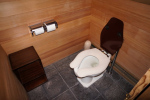 And then there was this super bizarre thing we found in the restroom of an extremely high class restaurant. Doesn’t look too bad at first glance, but take a closer look.
And then there was this super bizarre thing we found in the restroom of an extremely high class restaurant. Doesn’t look too bad at first glance, but take a closer look.
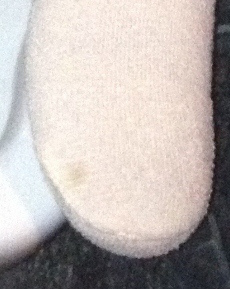 Yup, the toilet seat has a fuzzy cover. And that’s a STAIN on it. I don’t know about you, but I like my toilet seat covers disposable, thank you very much.
Yup, the toilet seat has a fuzzy cover. And that’s a STAIN on it. I don’t know about you, but I like my toilet seat covers disposable, thank you very much.


December 3, 2012
A Tour of Japanese Pop Culture, Part 9: The all-you-can-eat cake buffet!
A major con of traveling in Japan, and Tokyo in particular, is that food is expensive. A single apple can cost ¥200 (over two dollars). Still, you can find reasonably priced meals if you know where to look. Our tour guide took us to a number of affordable restaurants, all in the city. Another option is preprepared food at supermarkets. My husband and I just happened to be in the Mitsukoshi Department Store basement (where their supermarket is located) right when the prepackaged sushi got slashed from 50% off to 75% off. My husband wound up with 24 pieces of sushi for less than ¥1000! (And it was good, too!)
And as surprising as it may sound, all-you-can-eat establishments do exist in Japan, although the Japanese have their own twist on the concept.
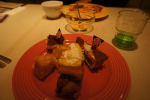 I first heard of all-you-can-eat cake parlors in shojo manga. Actually, I thought they were a joke, a figment of a sugar-obsessed mangaka’s imagination. But then I overheard our tour guides talking about the all-you-can-eat cake buffet they visited. My husband and I were instantly intrigued, and a few nights later, we were in Sweets Paradise.
I first heard of all-you-can-eat cake parlors in shojo manga. Actually, I thought they were a joke, a figment of a sugar-obsessed mangaka’s imagination. But then I overheard our tour guides talking about the all-you-can-eat cake buffet they visited. My husband and I were instantly intrigued, and a few nights later, we were in Sweets Paradise.
Sweets Paradise is a restaurant chain with several locations. The one we went to was on the fourth floor of the Marui City Mall near Shibuya Station. By the way, if you head to that particular location, the mall sign reads “Oi City.” (“Maru” means round in Japanese. Ergo “O”i City = “Maru”i City.)
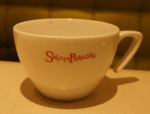 Here’s how it works. At the restaurant entrance is a machine where you purchase a meal ticket (1480 yen for adults and 840 yen for kids). You then hand it over to the hostess, and once she seats you, you have 90 minutes to eat as much as you like. You can order tea from the wait staff, get coffee and soda from self-serve dispensers, and help yourself to the buffet line goodies. The selection includes a few veggies, soup, curry, rice, and four different pastas. When the chef puts out a freshly cooked batch of pasta, she shouts to let the patrons know.
Here’s how it works. At the restaurant entrance is a machine where you purchase a meal ticket (1480 yen for adults and 840 yen for kids). You then hand it over to the hostess, and once she seats you, you have 90 minutes to eat as much as you like. You can order tea from the wait staff, get coffee and soda from self-serve dispensers, and help yourself to the buffet line goodies. The selection includes a few veggies, soup, curry, rice, and four different pastas. When the chef puts out a freshly cooked batch of pasta, she shouts to let the patrons know.
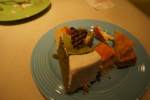 And of course there are the sweets! More than half the buffet line was taken up by the dessert display which included cheesecake, roll cakes, mousse cake, cream pastries, pudding, and even shaved ice, sweet red bean, and jelly cubes. Please note that though the cakes look very Western, they are geared toward a Japanese palate. Green tea flavored several desserts, one cake was made with sweet potato, and another was topped with a sesame seed sauce. I thought it was great, and my husband sampled every dessert on display.
And of course there are the sweets! More than half the buffet line was taken up by the dessert display which included cheesecake, roll cakes, mousse cake, cream pastries, pudding, and even shaved ice, sweet red bean, and jelly cubes. Please note that though the cakes look very Western, they are geared toward a Japanese palate. Green tea flavored several desserts, one cake was made with sweet potato, and another was topped with a sesame seed sauce. I thought it was great, and my husband sampled every dessert on display.
I should mention that the clientele was almost entirely female. Most looked like groups of girlfriends who’d been shopping together. The only exceptions were my husband and – you guessed it – another guy with his date. I don’t know why, but sweets are viewed as girly stuff in Japan, ergo, these establishments cater to women.
My husband didn’t care about that at all. For ¥1480, he’d run back to Sweets Paradise for another round even without me.


November 29, 2012
A Tour of Japanese Pop Culture, Part 8: Traveling on Tokyo’s Trains
I’ve mentioned trains and train stations number of times so I should probably give a little more information about them. Japan has an extensive, efficient public transportation system. For most areas in the country, taking the train is the most economical way to go. It can be a little overwhelming though.

This is the Tokyo subway, which is actually a combination of railways run by several different companies. I first traveled it was 1995 when I was an undergrad traveling with several other American and Japanese college students. I saw the map and thought it was a piece of artwork. No joke.
Even having grown up traveling San Francisco Muni, I found Tokyo’s subway incredibly intimidating. So I stuck to my Japanese friends like Velcro, terrified of getting lost alone. Almost 20 years later, I had to navigate these rails again, this time with only my husband, whose Tokyo train experience was as limited as mine. Fortunately, English-speaking travelers now have tools to make the trains much less bewildering, and chief among them are: Hyperdia, Suica and PASMO.
Hyperdia: this website provides transit information in English, Japanese, and Chinese. You simply enter your location and desired destination, the time of departure/arrival, and Hyperdia will tell you which trains you need to take, and the transfer points and times. An app is available so if you have a smartphone, you can recalculate your route if you get lost or miss a train. No need to bother with maps or train schedules!
Suica/PASMO: If you’re going to take the subway only once or twice, then purchase a ticket at the ticket counter or ticket machine (most have a button that says “English” that will give you instructions in English). But if you’re going to be on the train multiple times over several days, it will behoove you to get a PASMO or Suica card.
These are transit debit cards. Suica is distributed by JR (Japan Railways) and PASMO by Tokyo Metro, but really both cards are interchangeable and will work with practically all the local train lines in the greater Tokyo area.
You simply purchase a card for ¥500 and then load it with credit (in increments of ¥1000). To use it, you scan the card when you enter a station and when you exit at your destination. Whenever you scan your card, the turnstile screen will show how much credit you have remaining.
The card saves you the hassle of constantly purchasing tickets (and carrying coins and figuring out which ticket to buy and transfers from one rail company to another, etc.). And if your card comes up short at your destination, you simply take it to an “add fare” machine, which will calculate the necessary credit for you to complete your trip.
They’re similar to the TAP (Transit Access Pass) cards being implemented in the LA area but better. Suica/PASMO also works at participating vending machines, restaurants, and stores. So if you’ve got no change on hand for a snack (or if you loaded way more credit than you’ll need for travel onto your card), you can use your Suica/PASMO credit to get a beverage or meal.
Once you’re done traveling, you can get a refund for your remaining balance and deposit by turning your Suica in at a JR station ticketing office. PASMO cards can also be refunded, but I’m not exactly sure where.
These tools definitely made things easier traveling in Tokyo this time around.
Another thing that helps make the subway navigable is that station and train signs are in kanji and Roman letters so you can at least read the station names. Electronic signs, like the ones indicating track numbers at JR stations, will usually flash between English and Japanese. And these signs are everywhere. Even if you’re at a monster station like Shibuya, as long as you know what train you want and you’re at the right station, it won’t be very long before you find a sign pointing you toward the right track.
And DO check signs before you enter a turnstile. As mentioned before, multiple companies run Tokyo’s trains, and a single train station may have several sets of turnstiles leading to different tracks. For instance, the Asakusa and Mita lines both go through Mita Station, but there are separate turnstiles for each line.
A few last things of note:
Trains do get crazy crowded at peak times. So if you’re carrying a lot of bags during rush hour, you’re in for a world of hurt.
When you’re packed that tight and someone coughs, there’s no escape. So you might consider wearing disposable face masks as the locals do. No one will think it’s weird. We bought a box of masks at a pharmacy for 600 yen and wore them the entire time we were traveling.
Trains end service around midnight. If you miss the last train, you can hang out at an all-night restaurant or manga cafe until they resume service in the wee hours of the morning.


November 26, 2012
Writing Contest Alert: Pitch Wars!
If you’ve got a finished manuscript that you’re trying to polish nice and pretty for querying, Brenda Drake’s got a contest you’ll want to check out! Pitch Wars is an event where agented authors, industry interns, and editors team up with aspiring writers to shine up their manuscripts and pitches to present to some awesome agents!
They’re taking applications from aspiring writers in MG, YA, NA, and adult from now till December 5, 8PM EST.
For more details about the contest and coaches, go to Ms. Drake’s website!


November 21, 2012
A Tour of Japanese Pop Culture, Part 7: Hello Kitty and Sanrio’s Puroland
If the Ghibli Museum is on one end of the themed attraction spectrum then Puroland is definitely on the other. Sanrio’s theme park features bright colors, dazzling lights, costumed characters, Chinese acrobats, lively music, and you can take all the pictures and video you want!
Just so you know, this sojourn to Hello Kitty’s home turf was on account of my husband, not me. Despite his indifference to real cats (he’s allergic to them), he’s a tremendous fan of fictional kitties with no mouths. So when he saw the advertisement for Puroland, he was determined to pay homage to Japan’s feline ambassador!
 It was pure Sanrio sensory overload. Hello Kitty and her friends aren’t just posing for photographs with kids. We arrived as their main show “Believe” was taking place at the Wisdom Tree Stage in the center of Puroland. Just about every Sanrio character imaginable was singing and dancing accompanied by dozens of fantastically dressed performers and even several Chinese acrobats! Hello Kitty’s and Dear Daniel’s costumes were glittery with LEDs, and there were laser lights and other special effects to dazzle the crowd. I could only pick up a little of the dialogue (entirely in Japanese, no subtitles), but it was a mesmerizing start to a Wonderland-esque day.
It was pure Sanrio sensory overload. Hello Kitty and her friends aren’t just posing for photographs with kids. We arrived as their main show “Believe” was taking place at the Wisdom Tree Stage in the center of Puroland. Just about every Sanrio character imaginable was singing and dancing accompanied by dozens of fantastically dressed performers and even several Chinese acrobats! Hello Kitty’s and Dear Daniel’s costumes were glittery with LEDs, and there were laser lights and other special effects to dazzle the crowd. I could only pick up a little of the dialogue (entirely in Japanese, no subtitles), but it was a mesmerizing start to a Wonderland-esque day.
What to expect at Puroland
Puroland is an indoor theme park, which means you don’t have to worry about snow or heatstroke. It consists of four levels: ground, top, and two lower levels.
Ground level (3F)
 This is where visitors first step into Puroland. Beyond the ticketing booths is an expansive foyer with an information table. There are a couple signs in English here, but beyond the entry, signs are generally Japanese only. Puroland does provide pamphlets in various languages though.
This is where visitors first step into Puroland. Beyond the ticketing booths is an expansive foyer with an information table. There are a couple signs in English here, but beyond the entry, signs are generally Japanese only. Puroland does provide pamphlets in various languages though.
You can also find storage lockers and a stroller parking lot (Puroland has no elevators so parents have to check in their strollers here). Puroland’s main store is also by the entrance. Other shops and merchandise booths are located throughout Puroland, but this is the biggest one, offering DVDs, clothes, plushies, and confections shaped like your favorite characters.
Top level (4F)
Go up the grand staircase from the entry, and you’ll find Cinnamon Dream Café, Food Machine Restaurant, and Restaurant Yakata. Yakata, which serves lunch and dinner, is an all-you-can-eat buffet and therefore pricier so we opted to eat at the Food Machine Restaurant. Food Machine is cafeteria-style, offering Western and Japanese fare and nikuman stamped with Hello Kitty’s face. The decor is very steampunk with whirly-gigs decorating the food line. It is also very family-friendly. Every table has a Hello Kitty highchair already in place.
 Also on this level is a Vivitix boutique, where we finally found a Hello Kitty necktie for my husband. Seriously, we’ve been trying to find one for two years. (Apparently they’re only sold in Japan.) Now we’ve finally got one, though he decided to pass on the boxer shorts.
Also on this level is a Vivitix boutique, where we finally found a Hello Kitty necktie for my husband. Seriously, we’ve been trying to find one for two years. (Apparently they’re only sold in Japan.) Now we’ve finally got one, though he decided to pass on the boxer shorts.
Lower level 2F
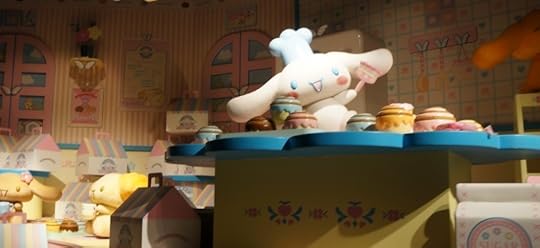 If you take the escalator down from the Puroland main entrance, you wind up on this level. The main attraction here is the Sanrio Character Boat Ride. Yes, it’s total ripoff of the “It’s a Small World” ride. But we still like it better because it didn’t have the annoying song and it’s all Sanrio characters. There’s a story and dialogue to go the ride, but it’s all in Japanese. From what I could piece together, it’s about Hello Kitty inviting all her Sanrio friends to a big shindig and them coming from around the world to join the party.
If you take the escalator down from the Puroland main entrance, you wind up on this level. The main attraction here is the Sanrio Character Boat Ride. Yes, it’s total ripoff of the “It’s a Small World” ride. But we still like it better because it didn’t have the annoying song and it’s all Sanrio characters. There’s a story and dialogue to go the ride, but it’s all in Japanese. From what I could piece together, it’s about Hello Kitty inviting all her Sanrio friends to a big shindig and them coming from around the world to join the party.
Bottom Level (1F)
If you take the grand staircase down from the boat ride, you wind up on the bottom floor, and this is where most of the action is. In addition to their main “Believe” production, the Wisdom Tree Stage presents smaller scale performances throughout the day, and additional shows take place in Puroland’s other three theaters.
 The glitziest of these is the Marchen Theater where we saw Sanrio’s rendition of the Wizard of Oz. It’s a fun, slightly wacky musical with Hello Kitty in glitter sneakers, a Wicked Witch of the West who’s a junkfood junkie, and a Las Vegas style finale. Given all the running around, I’m extremely impressed by Puroland’s performers. It can’t be easy doing dance numbers in a costume with a giant cat head on. This was the one show that had the dialogue translated into Chinese and English on a side screen.
The glitziest of these is the Marchen Theater where we saw Sanrio’s rendition of the Wizard of Oz. It’s a fun, slightly wacky musical with Hello Kitty in glitter sneakers, a Wicked Witch of the West who’s a junkfood junkie, and a Las Vegas style finale. Given all the running around, I’m extremely impressed by Puroland’s performers. It can’t be easy doing dance numbers in a costume with a giant cat head on. This was the one show that had the dialogue translated into Chinese and English on a side screen.
 My Melody’s Legend of Flowers and Stars was the musical playing at the Fairyland Theater. The production was not as grand as the Wizard Of Oz, but it was my favorite of the shows we saw. While Wizard of Oz is family fare, Legend is geared more toward a tween/teen audience. Despite My Melody’s name in the title, the rabbit’s really just a narrator. It’s a romance about two fairy lovers played by performers who look like B-List Japanese idols. And it had two super awesome Chinese acrobats as part of the act.
My Melody’s Legend of Flowers and Stars was the musical playing at the Fairyland Theater. The production was not as grand as the Wizard Of Oz, but it was my favorite of the shows we saw. While Wizard of Oz is family fare, Legend is geared more toward a tween/teen audience. Despite My Melody’s name in the title, the rabbit’s really just a narrator. It’s a romance about two fairy lovers played by performers who look like B-List Japanese idols. And it had two super awesome Chinese acrobats as part of the act.
By the way, the Fairyland Theater is located in the Fairyland wing, and Sanrio went overboard in giving it an enchanted forest atmosphere. It’s kind of cool that the interior of the theater, from the stage to the audience seats and tables, makes you feel like you’re sitting amidst trees, but it’s a little odd in the bathroom. The toilet flush handle in the women’s room was shaped like a tree branch, and my husband said the urinals were shaped like trees. (Ummm… yeah, he peed into a tree at Puroland.)
 In addition to the different stages and little workshop displays, this floor also features Hello Kitty’s house. Enter, and you can sit in her dining room, check out her bookshelf (apparently, she’s into Western literature), climb into her tub, and tap at her computer. And make sure you exit at the end of the house. There, you can get a picture with Hello Kitty herself before you leave her abode. Puroland staff will take one photo (and only one) with your personal camera and another on theirs (which you can buy for a fee).
In addition to the different stages and little workshop displays, this floor also features Hello Kitty’s house. Enter, and you can sit in her dining room, check out her bookshelf (apparently, she’s into Western literature), climb into her tub, and tap at her computer. And make sure you exit at the end of the house. There, you can get a picture with Hello Kitty herself before you leave her abode. Puroland staff will take one photo (and only one) with your personal camera and another on theirs (which you can buy for a fee).
I alluded to it before but just to emphasize, Puroland is extremely family-friendly. Most of the entertainment on the center stage is designed for kids, and there are changing facilities for babies. We visited on a Japanese holiday, and the majority of patrons were families with kids ranging from babies to middle school-age sons and daughters. Also in the mix were teenage girls in small groups and a few young couples. And then there were us.
What can I say? Hello Kitty attracts all sorts.
Between the shows, Hello Kitty’s house and all of Puroland’s other exhibits and entertainment, my husband was in Hello Kitty heaven. We explored most of it over the span of the day, but if we return to Japan, we will probably be making another trip to Puroland.
Going to Puroland
 Getting to Hello Kitty’s house is pretty straightforward. If you’re coming straight from the airport, you can take a limousine bus. (They call it a limousine bus, but it’s really just a tour group sized bus. It is comfortable though.) Otherwise, take the train to Tama Center Station, which is what we did.
Getting to Hello Kitty’s house is pretty straightforward. If you’re coming straight from the airport, you can take a limousine bus. (They call it a limousine bus, but it’s really just a tour group sized bus. It is comfortable though.) Otherwise, take the train to Tama Center Station, which is what we did.
Adjacent the train station exit is a huge outdoor mall where Puroland is located. Puroland is clearly indicated on the mall map.
 No reservations are necessary! Just go and buy your tickets. You’ll need to decide which type of tickets though. The cheaper option only gives access to the center stage shows. If you want access to the other theaters or attractions such as the Boat Ride and Kitty’s house, you’ll need the more expensive ticket.
No reservations are necessary! Just go and buy your tickets. You’ll need to decide which type of tickets though. The cheaper option only gives access to the center stage shows. If you want access to the other theaters or attractions such as the Boat Ride and Kitty’s house, you’ll need the more expensive ticket.
If you’re visiting from abroad, I say get the more expensive ticket. You certainly won’t have the option to experience that much Sanrio goodness when you get home.


November 19, 2012
A Tour of Japanese Pop Culture, Part 6: The Ghibli Museum
Studio Ghibli is among the greats in the world of anime so part of our guided tour included a visit to the Ghibli Museum. Like Maidreamin and Swallowtail, it has a strict “no-photo” policy, the only exceptions being the rooftop garden and Totoro’s Reception Area at the entrance. But hopefully, these few shots will convey the flavor of the museum.

Totoro’s Reception Area
I think they categorized this place as a museum because A) it’s not an amusement park (no rides) and B) it does have art exhibits. When we visited, it had a special exhibit on European fairytales (I think). But it’s so engaging and entertaining it goes beyond what most people think of as a museum.
The building itself was like something out of a pastoral Ghibli film. Located in Mitaka Inokashira Park, which itself is a beautiful place, the museum exudes a nostalgic kind of elegance through an interesting combination of polished wood architecture and Art Deco/steampunk touches. No bright lights or gaudy decor here. Yet it bears the Ghibli stamp everywhere you look. From the Totoros in the stained-glass windows to the Jiji cat faucet handles by the Straw Hat Café to the tiles in the bathroom. One of the Canadians in our group declared that she wanted to move right in!
 The museum is definitely kid-friendly. For instance, the film we saw it at the museum (an original short that can only be seen there) was approximately ten minutes, perfect for a kid’s attention span. It also had no dialogue. (No need to worry about vocabulary and hey, that’s great for foreign visitors, too!). Plus, the theater benches were child-sized so all of us adults were sitting with our knees up to our chests. The spiral staircase in the main atrium is sized for kids, the Cat Bus play room on the third floor is limited to small children only, and the animation exhibits on the first floor are designed such that the best view is at kid height.
The museum is definitely kid-friendly. For instance, the film we saw it at the museum (an original short that can only be seen there) was approximately ten minutes, perfect for a kid’s attention span. It also had no dialogue. (No need to worry about vocabulary and hey, that’s great for foreign visitors, too!). Plus, the theater benches were child-sized so all of us adults were sitting with our knees up to our chests. The spiral staircase in the main atrium is sized for kids, the Cat Bus play room on the third floor is limited to small children only, and the animation exhibits on the first floor are designed such that the best view is at kid height.
 Still, it was plenty interesting for us adults (although we did have to bend over and kneel to take in some exhibits). Rooms on the second floor provide more grown up fare with an exploration of Hayao Miyazaki’s creative process. It takes you from a mockup of his drawing board and reference materials to exhibits that demonstrate the nuts and bolts of creating an animated film. Unfortunately, all the signs were in Japanese, but it was still cool to see preliminary sketches for classics such as Totoro, Kiki’s Delivery Service, and Princess Mononoke.
Still, it was plenty interesting for us adults (although we did have to bend over and kneel to take in some exhibits). Rooms on the second floor provide more grown up fare with an exploration of Hayao Miyazaki’s creative process. It takes you from a mockup of his drawing board and reference materials to exhibits that demonstrate the nuts and bolts of creating an animated film. Unfortunately, all the signs were in Japanese, but it was still cool to see preliminary sketches for classics such as Totoro, Kiki’s Delivery Service, and Princess Mononoke.
Yes, there is a gift shop (MAMMA AIUTO!). Yes, the goods there are really cool. No, we didn’t buy anything because everything was crazy expensive. We drooled at the Ghibli necktie, but we couldn’t justify paying $90 for it.
Visiting the museum
If you’re an anime fan visiting Japan, I highly encourage you to visit the museum. Our guide gave us about two hours there. I’d recommend allotting a half day if you want a leisurely visit, and tack on additional time if you want lunch at the museum cafe. By the way, despite Mitaka being some distance from the middle of Tokyo, a significant number of foreigners live there, and you can find a decent variety of international food in the area.
Tickets must be purchased IN ADVANCE (see their website for details). I REPEAT , you must make a museum reservation AHEAD OF TIME. (This doesn’t mean the museum won’t be crowded though. Three separate school field trips were crawling around the place while we were there).
There’s no visitor parking at the museum so your best bet is to take the train to Mitaka Station. A bus runs between the station and the museum, but you can also walk (approximately 15 min.) to get there.
By the way, if you walk, you get a little bonus. Signs along the route point the way to the museum, and they are, of course, done in Ghibli style.

















